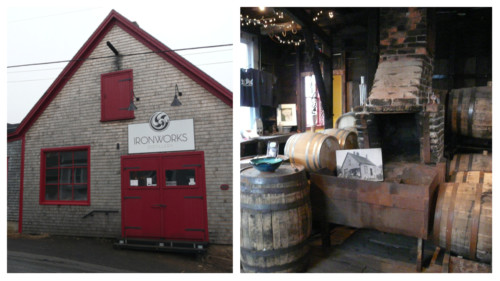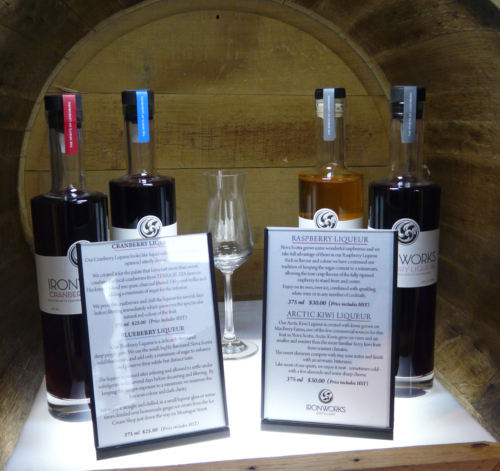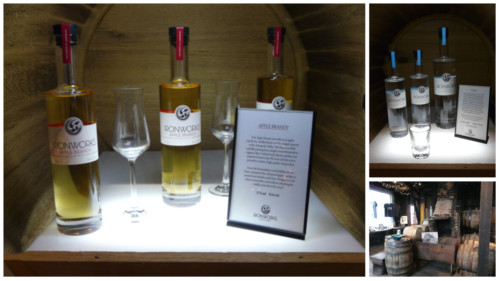Taste the Spirits of Lunenburg
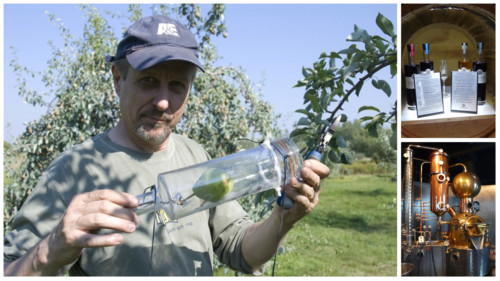
In the Bluenose Era, the 1920s and 1930s, Lunenburg was a hive of activity, the harbour filled with masts and sails, including those of the famous schooner Bluenose. This was also the time of prohibition and the highly romanticized “rum running” era.
In the coming months of 2012, this world heritage site will be revitalized with the arrival of Tall Ships and the re-launch of the Bluenose. Along with the ships, a hidden treasure at the waterfront – a former blacksmith’s shop, now the craft distillery, Ironworks, will afford a sensory rich opportunity to ‘taste the spirits of Lunenburg’.
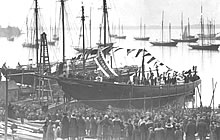
The harbour has long been Lunenburg’s “eau de vie”. It has been the place from which new ventures were successfully launched – ship building, marine resource harvesting, international trade … it is a place of world significance.
Well, the future often reflects the past – the recently launched Ironworks is a distillery with world connections. Their fine liqueurs, eau de vie, rums and vodkas bring to world travellers tastes of Nova Scotia. Apples, pears and berries augment the silky smoothness of their unique tasting opportunities.
The searing heat of the fire in the forge, the ringing sound of the anvil – reverberations of Thomas Walters’ turn of the century blacksmith days resonate within the Ironworks Distillery. The building housing Ironworks was, until recently, the Walters Blacksmith Shop and had been in continuous use by the Walters family since 1893. The Walters Blacksmith Shop had the distinction of being the shop chosen to do the “shipsmithing” (ironworks) for the original Bluenose, the Bluenose II, the HMS Rose and the HMS Bounty replica.
In the summer of 2009, Pierre Guevremont and Lynne MacKay began renovation of that blacksmith shop, to create a working area for their beautiful German-made still, affectionately named “Bergita”, as well as a tasting and shopping venue for future customers. Pierre and Lynne took care to preserve the unique historical character of this late 19th century building, one of the landmarks of the Old Town. Three months later, their first batch of vodka made its way from an unassuming copper tube to a few testing glasses on their kitchen table.
More than Spirits in the Bottle
But more artistry for the eyes and mind abounds within the walls of this heritage building.
Many coastal communities can tell you “how they got the ship in the bottle”; but only Lunenburg’s Ironworks can show you how to grow a pear in a bottle – “eau de vie de poire”.
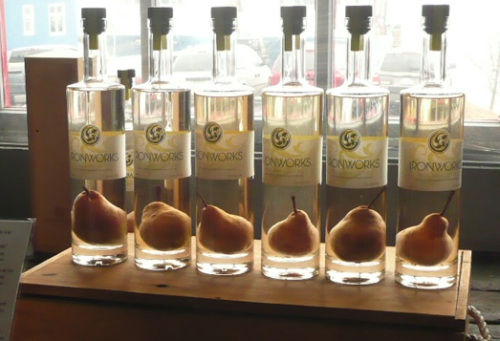
Set below the window looking onto the harbour, is a magician’s table of bottles, each containing a fully matured pear. The clear liquid enveloping the pear is a silky smooth elixir of eau de vie flavoured by the pear.
The eau de vie was created from the fermentation of a mash of whole pears (stems, seeds, skins and all) which occurs in the building’s original stone-lined basement.
Centre stage in the distilling process is “Bergita”, the magnificent copper and stainless steel pot still. Bergita boils the mash, collects the alcohol vapour as it rises, then cools that vapour back to a liquid – distilled alcohol, and each time the product goes through the still, it rises in proof. On each run, Pierre and Lynne can decide when to keep the alcohol and when to discard it. This process, called removing the “heads and tails”, leaving the “heart”, brings out the art of distilling and the personal style of the distiller.
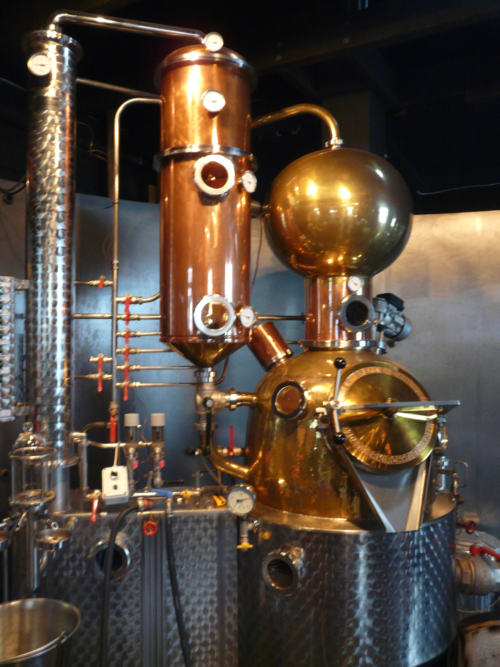
But how did the pear get in the bottle? Well it just grew there!
Actually, in the spring, Ironworks artisans tie over 300 bottles in the trees of a Valley pear orchard. Each bottle contains a pear bud. Carefully nurtured throughout the summer; the bottles are “picked from the trees” – with the pear inside.
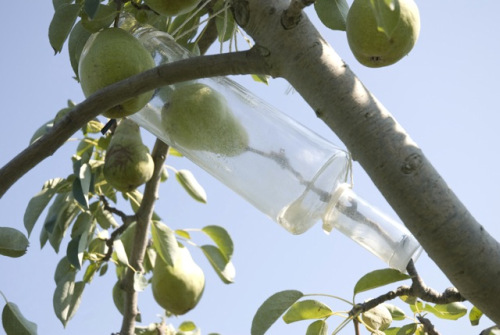
Sounds a little quirky? Well in Europe, there are hundreds of such bottled trees being harvested each year in support of the èau de vie liqueur industry.
The Nose Knows
While the eyes and mind are deceived by the bottled pear, descending the stairs to the fermentation room is an aromatic experience never to be forgotten.
At the doorway of this warm “womb” of the distillery, you encounter a virtual wall of pleasurable scents revealing the many Nova Scotian fruits which are the key ingredients in the distillery’s array of tastes. Pierre and Lynne source their fruits and berries from throughout Nova Scotia. Boates orchards is the place where the apples and pears are ground to a mash, step one in the stilling process.
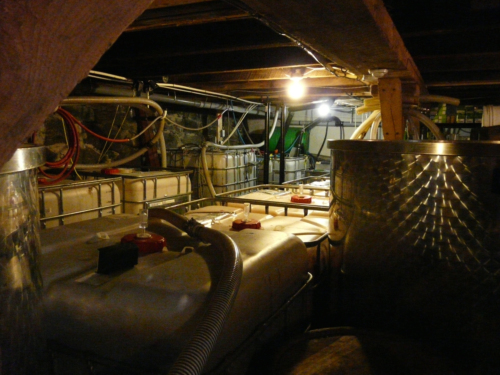
Along with these fruits is molasses developed from Guatemalan sugar cane, from New Brunswick. Two hundred litres of molasses combined with eighteen hundred litres of water yields the right amount of brix (sweetness measure) for rum making.
The “fermentation stage” is a four to six week process. Compare that with only three to four days in the big US distilleries. These artisans take their time to produce their silky smooth rums, vodkas and liqueurs.
In this historic cellar, with stout beams capable of supporting the two black forges above, your feet are surprised by the warmth of the new cement floor. How is this possible? The boiling waters of the distillery are cycled throughout the building and floor…keeping both Ironworks artisans and spirits efficiently warmed.
Two Noses are better than one
We asked Lynne about the best ways to appreciate her spirits of Lunenburg, and we were surprised when in guiding our scenting of the liqueurs, she advised us to use both nostrils separately – apparently our sensory proficiencies vary from one to the other.
And then we learned another trick. Hold your nose closed as you first taste the liqueur; and then released the nostrils … your tastes buds on the tongue combine their discoveries with those of your “noses” and you will be able to sense even a wider array of tastes. The mind is enriched.
Lynne showed us the tasting glasses she feels are suited for liqueurs – they have a chimney shape, as opposed to the wide open mouths of wine and sherry snifters – all the better to capture and funnel the scents to your nose.
Pearing or Pairing
Lynne advised us that her liqueurs are perfectly paired when matched with some of Nova Scotia’s best cheeses – those whose strength of character make you take notice. These are the cheeses that best complement the smooth and delicious sweetness of Nova Scotia raspberries, blueberries and cranberries. Lynne suggests you might also drizzle these special treats over a soufflé or ice cream.
At the end of a fine dining experience, the eau de vie de poire is nicely complemented by the flavours of fresh nuts – perhaps walnuts.
Your Daily Tot
Did you know that Canada`s Navy was the last navy in the world to offer a tot (a daily issue) of rum to the seamen?
When Ironworks was launched, the town “tasters” were quick to ascertain if rum would be a part of the distillery, and yes, along with vodka products, two wonderfully smooth sipping rums are given birth in the still.
In the coming guest season, Ironworks has partnered with Amos Pewter to create an authentic tot glass as well.
Artistic Spirits of Ironworks
The artists you’ll see at work in the Ironworks distillery, Pierre Guevremont and Lynne MacKay, with the assistance of Yuri Araj, the “keeper of the still”, produce:
Vodka (from Annapolis Valley apples)
Rum
Blueberry Liqueur ( blueberries from Van Dyk’s)
Cranberry Liqueur (cranberries from Terra Beata)
Eau de Vie
Apple Brandy
All these products are available at the distillery, Halifax Seaport Farmers’ Market, Bishop’s Cellar, Premier Wine & Spirits and Harvest Wine & Spirits.
Raison d’être
“The whole reason for doing this is to make something special and unique, with our personal stamp on it, that we hope other people will enjoy. We’re constantly experimenting with different varieties and combinations of fruit and other ingredients, hoping to discover new taste possibilities. We backed up hands-on lessons from generous established distillers with a formal course at the agricultural school of Cornell University. We researched the best distilling technologies, talking to manufacturers as far away as Germany and New Zealand.” – Lynne and Pierre (owners)
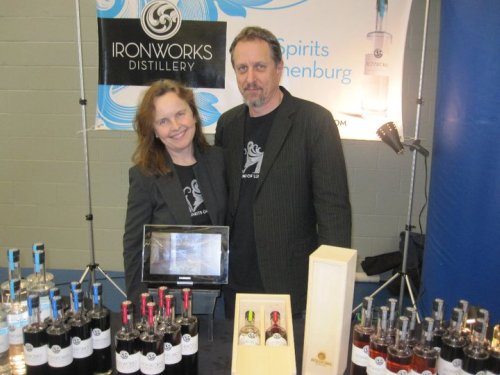
Lynne and Pierre are just back from a “learning vacation” in France, where they honed their craft, learning from the artisans of Calvados.
Cheers
Let your senses run wild within this heritage building of Ironworks, now transformed into a magical set of experience opportunities for the nose, the eyes, the taste buds, and perhaps most intriguing – the mind.
Lynne and Pierre invite you to enjoy a taste or two with them … with your feet up beside the old forge, watching the sunset through a jumble of masts in Lunenburg harbour. You can even take a horse-drawn buggy right to their door.

